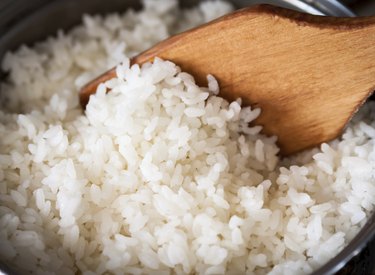
From white to brown to jasmine and wild, rice is one of the most versatile foods you can keep in your pantry. It not only adds texture but it's also a great vessel for foods and holds flavor very well. Think risotto, rice cakes and veggie burgers.
When it comes to cooking rice, there are many easy ways to do it — and you don't even need a rice cooker. One important thing to keep in mind, though, is that there are some food safety concerns to be aware of when cooking rice.
Video of the Day
Video of the Day
While rice is a less obvious candidate for causing foodborne illnesses, it's a potential vector for a number of unpleasant microorganisms. Here are some things you need to know about cooking, storing and reheating rice.
Why You Should Always Store Uncooked Rice in a Cool, Dry Place
Rice and other uncooked grains are relatively impervious to potentially harmful microorganisms or pathogens because they're so dry. Plus, rice needs to be cooked to be eaten, so in many ways, the cooking process makes it less of a vector for pathogens.
But it's important to take precautions and store rice properly so that bacteria and mold don't spread. It's best to freeze rice for a minimum of 48 hours after buying it to kill insect larvae that may be present in it.
"This is an optional step since many companies pre-rinse the rice, but better safe than sorry," Craig Emmons, an R&D chef at Freshly, tells LIVESTRONG.com.
While washing rice out of the bag sounds like a good idea for keeping microorganisms at bay, it only increases the potential for bacteria to grow, Jessica Levinson, RDN, CDN, a registered dietitian and culinary nutrition expert in Westchester County, New York, tells LIVESTRONG.com.
"If you wash rice immediately, you will not be able to store it once it's wet, and if you attempt to dry the rice in the microwave, you will ignite the cooking process," Levinson explains. So it's best to not wash your rice at all, unless a recipe calls for it, but you would do this step only right before cooking.
How to Store Uncooked Rice
- Once opened, Levinson says she likes to store her rice in a tightly sealed container in a cool, dry place. "At room temperature, uncooked white rice can be stored safely for six months and brown rice for three months.
- "Alternatively, you can store uncooked white and brown rice in the freezer indefinitely," she says. Emmons also likes to store his rice in an airtight container in his pantry. "A lot of rice comes in bags that aren't great, so I like to remove it from the bag and put it in containers or at the very least, a resealable Ziploc plastic bag," Emmons says.
How to Cool and Store Cooked Rice
If you're preparing enough rice for leftovers, it's important to cool it down once it's removed from the heat.
"To prevent bacteria and mold, the USDA recommends cooling rice to 70 degrees Fahrenheit within two hours and from 70 degrees to 40 degrees Fahrenheit within an additional four hours. Hold cold rice at 41 degrees Fahrenheit or below," Levinson says.
You can cool down rice by transferring it out of the pot and into containers or a baking sheet and fluffing it with a fork to release the steam. Levinson says cooked rice should be stored in a tightly sealed container in the fridge for three to five days, or in the freezer for up to six months.
If you're not storing the rice and keeping it warm for serving, then it must stay at 140 degrees Fahrenheit or hotter — out of the danger zone — to remain food safe, according to the USDA Food Safety and Inspection Service.
At lower temperatures, bacteria such as the rice-loving Bacillus cereus can quickly colonize the pot. If it's not stirred and fluffed, it's also possible for C. botulinum to reproduce in the airless environment and produce the toxin responsible for botulism.
Reheating Rice
If you're reheating leftover rice, it should be reheated to 165 degrees Fahrenheit to kill harmful bacteria, per the USDA Food Safety and Inspection Service.
How to reheat rice in a microwave: When reheating in the microwave, cover and rotate the rice so it retains its moisture and heats all the way through. Levinson says adding a little water to leftover rice when reheating it can also prevent it from drying out.
Frozen rice is best when eaten within four to six months. Thaw it overnight in the refrigerator, or if you'll be cooking it immediately you can use your microwave to initiate the cooking process.
Tip
Turn your leftovers into new meals by getting creative with your ingredients. For example, Levinson likes to use leftover rice as a base for buddha bowls and casseroles. She also likes to make veggie fried rice or mix leftover rice with beans and some fresh herbs for a side dish.
Was this article helpful?
150 Characters Max
0/150
Thank you for sharing!
Thank you for your feedback!